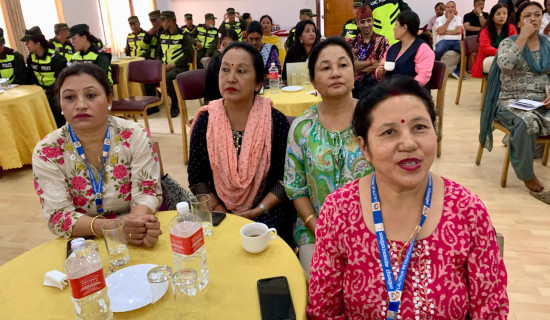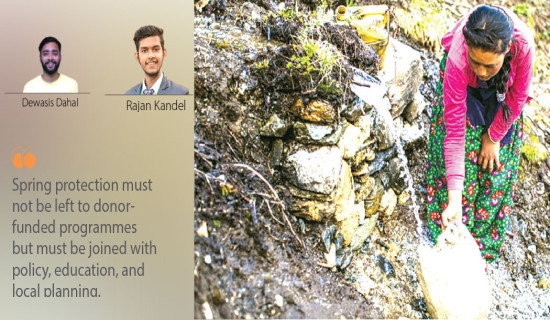- Saturday, 30 August 2025
Gathamuga: The burning of demon effigy
BY SUSHMA MAHARJAN,Kathmandu, July 22: During the day of Gathamuga or Ghantakarna, traditional marketplaces including Ason, Naradevi, Jaisidegal and Maru burst with activities. Street vendors line the streets, selling rings, iron nails, henna, black bangles, and puja materials. Children eagerly gather coins to buy straw and bamboo, preparing to build demon effigies that will later be paraded and burned.
Celebrated on Krishna Chaturdashi of the month of Shrawan, ‘Gathamuga’ is a Newar festival observed to drive away evil spirits, purify the home, and restore spiritual protection. Rooted deeply in mythology and agricultural tradition, it blends rituals, folklore, and symbolism to preserve a unique identity. This year, it is being observed on Wednesday, July 23.
Origins in myth and monsoon
Although the exact origin date is unknown, there is evidence of the festival’s observance during the Lichhavi period. The name itself has deep meaning. In the Newar language, ‘Ga’ means house, ‘Tha’ means pillars, and ‘Muga’ means strong, pointing to the importance of spiritual and structural strength within home.
In ancient times, during the monsoon season, Newars were occupied with rice plantation and fieldwork, often leaving their homes unattended and unclean. This was believed to lead to a buildup of negative energy and allow evil spirits to take shelter inside. Gathamuga, therefore, became a community cleansing ritual, physically, mentally, and spiritually.
Central to the mythology is the tale of ‘Ghantakarna’, a fearsome demon who terrorised communities, especially women and children, and disrupted religious activities. He wore a 46-47 kilograms bell (ghanta) in one ear (karna), which gave him his name. It is believed that he roamed the villages with a deafening bell, spreading fear and even consuming people.
According to legend, during one monsoon, a large number of frogs began to croak loudly, drowning the demon’s bell sound. Enraged, Ghantakarna began chasing them, but as the frogs dived into the water, the demon followed and eventually drowned. In gratitude, people worship frogs on this day for saving them from the demon.
Rituals of cleansing and protection
According to Ras Joshi, culture expert and lecturer at Patan Multiple Campus, Gathamuga is not just about myth or ritual, it reflects the Newar community’s relationship with fear, environment, and social harmony. “The festival embodies a psychological cleansing. The act of creating and burning a demon effigy allows people to collectively release negative energies and reinforce a shared sense of protection and wellbeing,” he added.
He said, “It also marks a crucial seasonal shift. Monsoon was historically a time of vulnerability, disease spread, productivity slump, and households were left unattended due to intense fieldwork. Gathamuga reconnects people with their households and reminds them the importance of cleanliness for good health.”
During the festival, Newar households deep-clean their homes. Effigies of ‘Ghantakarna’ is built using straw, hay, and bamboo, and placed at crossroads to represent chaos being removed from the community. Children collect donations from neighbours to make these effigies, encouraging unity and participation.
At home, a small ‘puja’ is performed. A ‘makal’, an earthen pot filled with coal, herbs, and three-headed nails, is lit to purify rooms. This is followed by the ritual known as ‘bau wayegu’ after the sun sets, in which items like rice, raw meat, garlic, spices, and flowers are offered to spirits to keep them away. A paper charm with mantras is nailed above doorways, and three-headed iron nails are hammered on the main door for protection.
“At night, we prepare the bau with raw meat, garlic, and rice, and place it at the crossroads to offer it to the spirits. The bau rituals are performed by the eldest male member of the family. He needs to carry bau to the crossroads barefoot without speaking a word, and after placing it there, he should not turn back until reaching home,” said Kiran Shrestha, a resident of Ason. “Additionally, we hammer iron nails at the entrance and hang protective charms. It’s said to keep evil spirits out.”
Moreover, as the sun sets, the effigies are dragged through the streets and set ablaze. This final act symbolises the destruction of evil, casting away of disease, and a renewed strength for the community.







-square-thumb.jpg)









